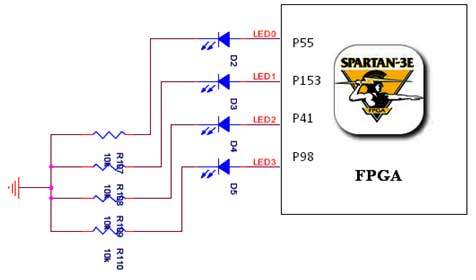
led interfacing with spartan 3e webserver

The Spartan-3E board features four LEDs connected to FPGA I/O pins, as detailed in the accompanying table. Each LED's cathode is connected to ground through a 330-ohm resistor. To illuminate a specific LED, the corresponding FPGA control signal must be set to High.
The Spartan-3E board is designed for various applications in digital logic and embedded systems, offering flexibility in controlling external components such as LEDs. Each LED is connected to a dedicated I/O pin on the FPGA, allowing for individual control. The use of a 330-ohm resistor in series with each LED is essential for current limiting, preventing excessive current flow that could damage the LED.
When the FPGA outputs a High signal to a specific I/O pin, the corresponding LED will turn on, as the voltage at the anode of the LED exceeds the forward voltage threshold, allowing current to flow from the anode to the cathode through the resistor. This configuration not only provides visual feedback in various applications but also serves as a fundamental example of interfacing digital logic with passive components.
In practical applications, this setup can be utilized in debugging, status indication, or user interface elements in a larger system. The Spartan-3E board's programmable nature allows for easy modification of the control signals, enabling dynamic LED control based on various input conditions or state changes within the FPGA.The Spartan-3E board has four LED Connected with FPGA I/O pins (details tabulated below). The cathode of each LED connects to ground via a 330 © resistor. To light an individual LED, drive the associated FPGA control signal to High. 🔗 External reference
The Spartan-3E board is designed for various applications in digital logic and embedded systems, offering flexibility in controlling external components such as LEDs. Each LED is connected to a dedicated I/O pin on the FPGA, allowing for individual control. The use of a 330-ohm resistor in series with each LED is essential for current limiting, preventing excessive current flow that could damage the LED.
When the FPGA outputs a High signal to a specific I/O pin, the corresponding LED will turn on, as the voltage at the anode of the LED exceeds the forward voltage threshold, allowing current to flow from the anode to the cathode through the resistor. This configuration not only provides visual feedback in various applications but also serves as a fundamental example of interfacing digital logic with passive components.
In practical applications, this setup can be utilized in debugging, status indication, or user interface elements in a larger system. The Spartan-3E board's programmable nature allows for easy modification of the control signals, enabling dynamic LED control based on various input conditions or state changes within the FPGA.The Spartan-3E board has four LED Connected with FPGA I/O pins (details tabulated below). The cathode of each LED connects to ground via a 330 © resistor. To light an individual LED, drive the associated FPGA control signal to High. 🔗 External reference





